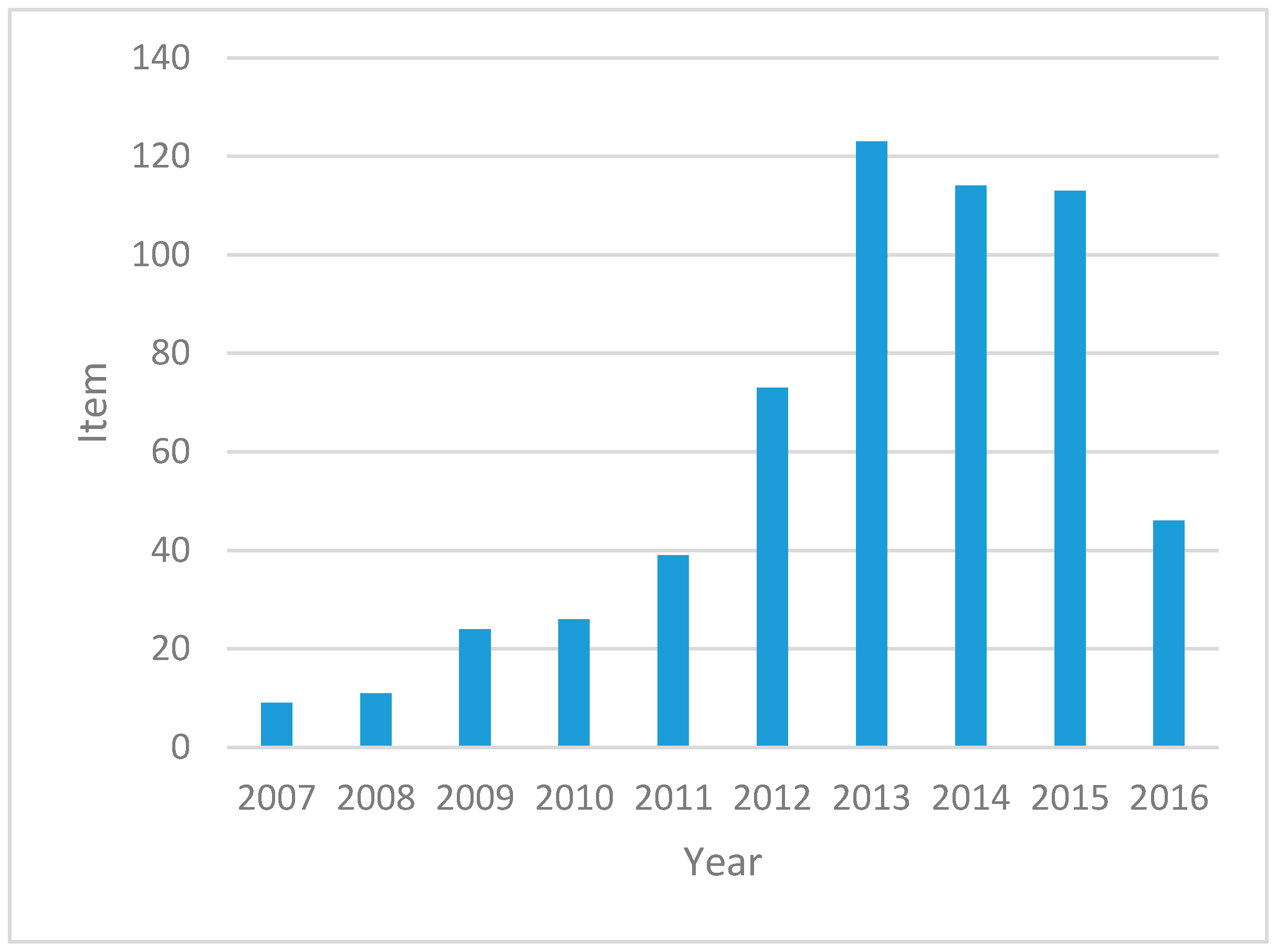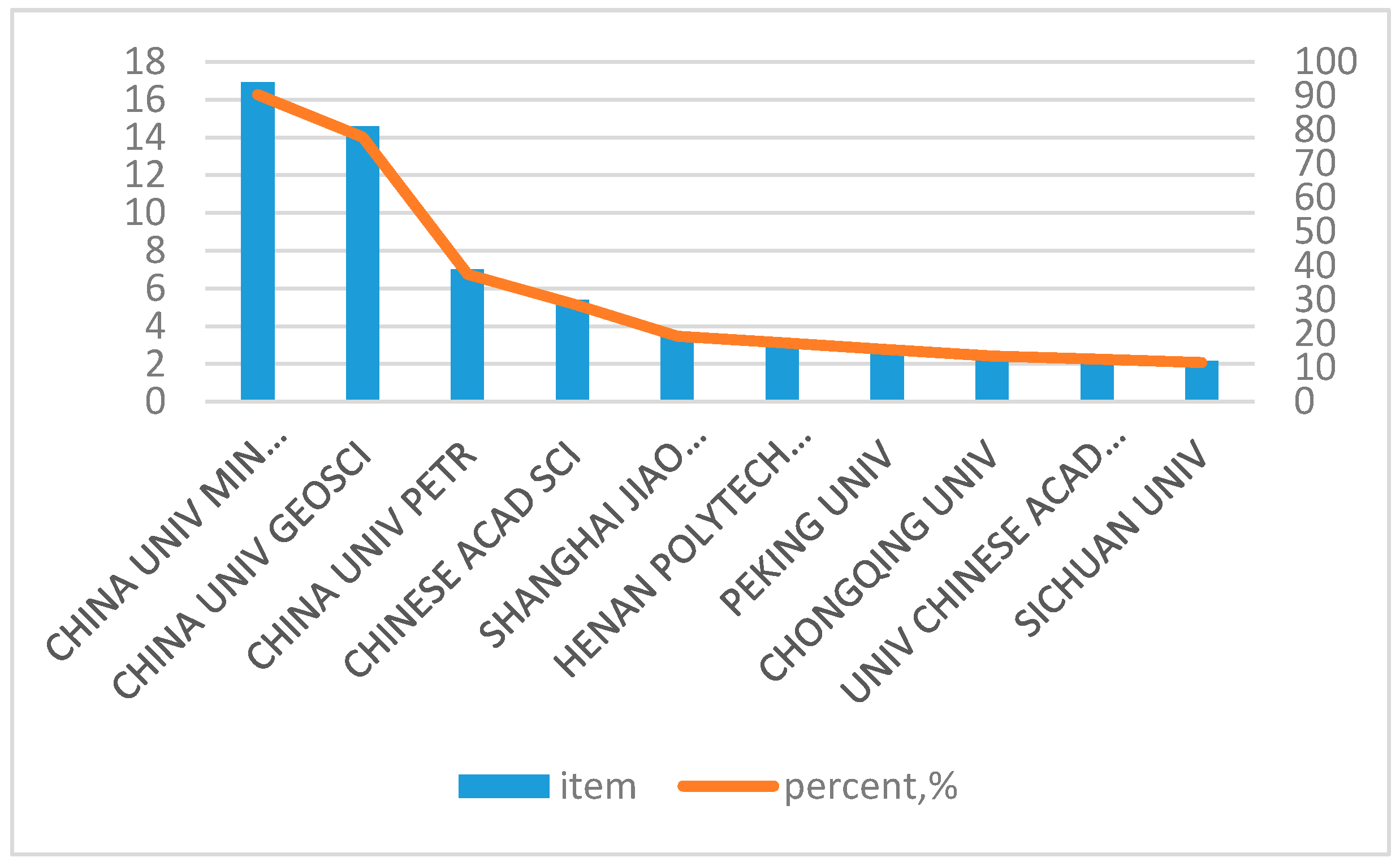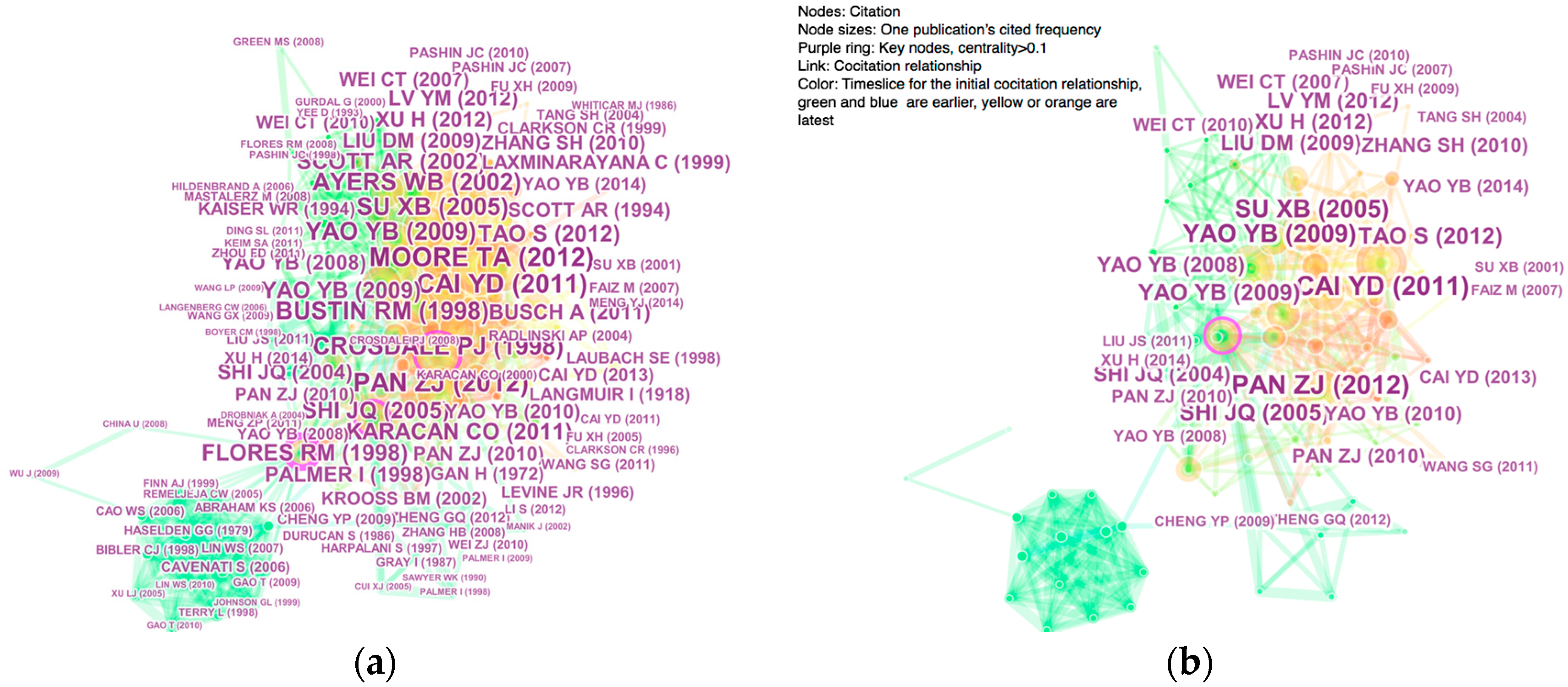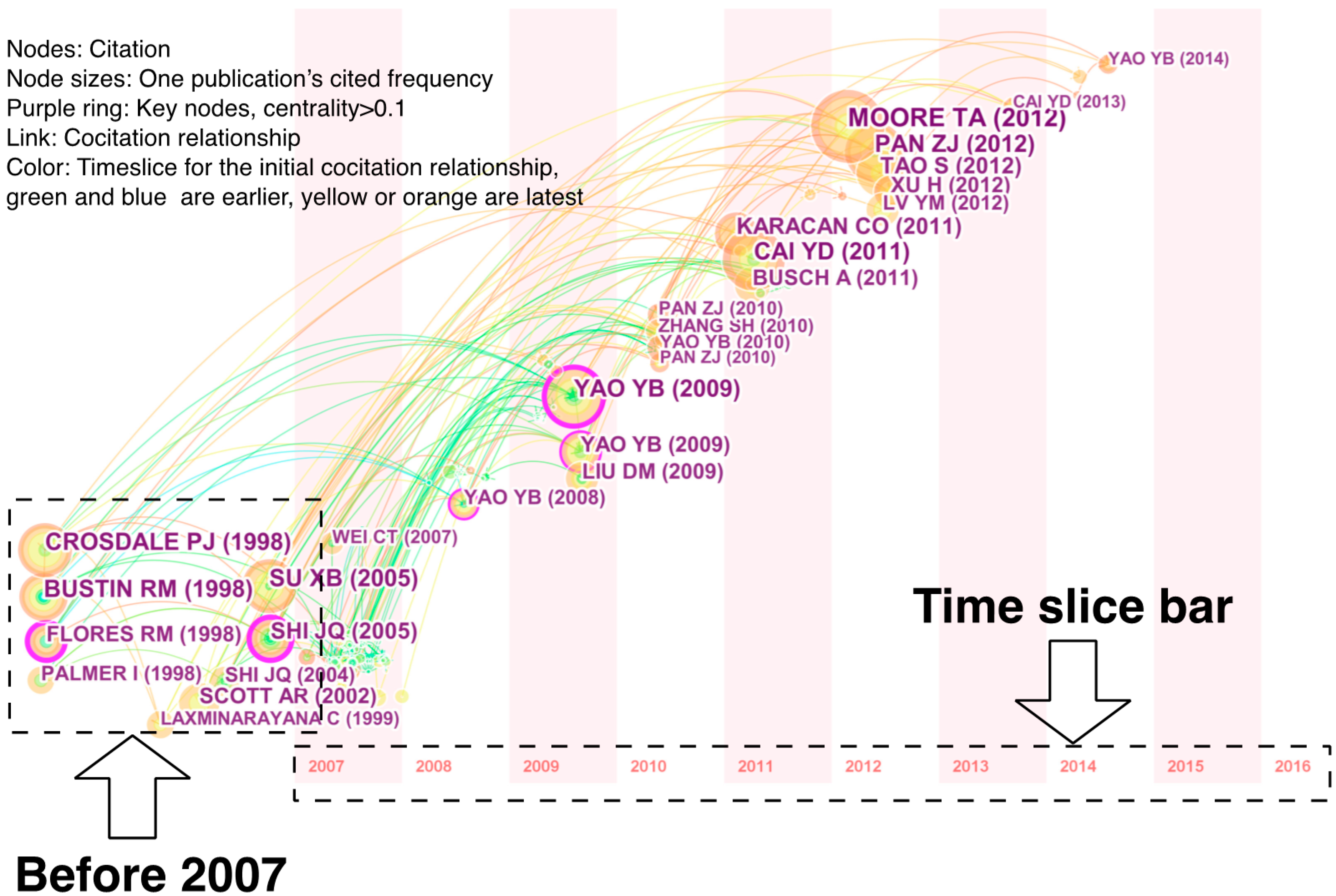Visualization of Chinese CBM Research: A Scientometrics Review
Abstract
:1. Introduction
2. Research Methods, Tools, and Data Sources
2.1. Research Methods
2.2. Tools
2.3. Data Sources
2.4. Distribution of Papers
3. Experimental Section
3.1. Co-Cited Network Mapping
3.2. Early Founding Literature and High Citing Frequency Literature
3.3. Previous Research
3.4. Visualized Analysis of Research Fronts, Hot Spots, and Discussion
3.5. Knowledge Tree Mapping
4. Conclusions
Acknowledgments
Author Contributions
Conflicts of Interest
References
- Moore, T.A. Coalbed methane: A review. Int. J. Coal Geol. 2012, 101, 36–81. [Google Scholar] [CrossRef]
- Riahi, K. Fifth Assessment Report; IPCC: New York, NY, USA, 2014. [Google Scholar]
- Li, B.; Gasser, T.; Ciais, P.; Piao, S.; Tao, S.; Balkanski, Y.; Li, L.Z. The contribution of China’s emissions to global climate forcing. Nature 2016, 531, 357–361. [Google Scholar] [CrossRef] [PubMed]
- Spracklen, D.V. Global warming: China’s contribution to climate change. Nature 2016, 531, 310–312. [Google Scholar] [CrossRef] [PubMed]
- Rightmire, C.T.; Eddy, G.E.; Kirr, J.N. (Eds.) Coalbed Methane Resources of the United States; American Association of Petroleum Geologists: Tulsa, OK, USA, 1984. [Google Scholar]
- Zhou, F.; Xia, T.; Wang, X.; Zhang, Y.; Sun, Y.; Liu, J. Recent developments in coal mine methane extraction and utilization in China: A review. J. Nat. Gas Sci. Eng. 2016, 31, 437–458. [Google Scholar] [CrossRef]
- Li, W.; Xu, R. Technology of gas drainage and utilization in Huaibei mining area. J. Coal Sci. Eng. (China) 2009, 15, 278–283. [Google Scholar] [CrossRef]
- Yun, J.; Xu, F.; Liu, L.; Zhong, N.; Wu, X. New progress and future prospects of CBM exploration and development in China. Int. J. Min. Sci. Technol. 2012, 22, 363–369. [Google Scholar] [CrossRef]
- Liu, D.M.; Li, J.Q. Main geological controls on distribution and occurrence and enrichment patterns of coalbed methane in China. Coal Sci. Technol. 2014, 42, 19–24. [Google Scholar]
- De Solla Price, D.J. Networks of scientific papers. Science 1965, 149, 510–515. [Google Scholar] [CrossRef]
- Mullins, N.C.; Hargens, L.L.; Hecht, P.K.; Kick, E.L. The group structure of cocitation clusters: A comparative study. Am. Sociol. Rev. 1977, 42, 552–562. [Google Scholar] [CrossRef]
- Chen, C. CiteSpace II: Detecting and visualizing emerging trends and transient patterns in scientific literature. J. Am. Soc. Inf. Sci. Technol. 2006, 57, 359–377. [Google Scholar] [CrossRef]
- Chen, C.; Ibekwe-SanJuan, F.; Hou, J. The structure and dynamics of cocitation clusters: A multiple-perspective cocitation analysis. J. Am. Soc. Inf. Sci. Technol. 2010, 61, 1386–1409. [Google Scholar] [CrossRef]
- Wang, X.; Nathwani, J.; Wu, C. Visualization of International Energy Policy Research. Energies 2016, 9, 72. [Google Scholar] [CrossRef]
- Crosdale, P.J.; Beamish, B.B.; Valix, M. Coalbed methane sorption related to coal composition. Int. J. Coal Geol. 1998, 35, 147–158. [Google Scholar] [CrossRef]
- Bustin, R.M.; Clarkson, C.R. Geological controls on coalbed methane reservoir capacity and gas content. Int. J. Coal Geol. 1998, 38, 3–26. [Google Scholar] [CrossRef]
- Ayers, W.B., Jr. Coalbed gas systems, resources, and production and a review of contrasting cases from the San Juan and Powder River basins. AAPG Bull. 2002, 86, 1853–1890. [Google Scholar]
- Scott, A.R. Hydrogeologic factors affecting gas content distribution in coal beds. Int. J. Coal Geol. 2002, 50, 363–387. [Google Scholar] [CrossRef]
- Su, X.; Lin, X.; Liu, S.; Zhao, M.; Song, Y. Geology of coalbed methane reservoirs in the Southeast Qinshui Basin of China. Int. J. Coal Geol. 2005, 62, 197–210. [Google Scholar] [CrossRef]
- Shi, J.Q.; Durucan, S. A model for changes in coalbed permeability during primary and enhanced methane recovery. SPE Reserv. Eval. Eng. 2005, 8, 291–299. [Google Scholar] [CrossRef]
- Yao, Y.; Liu, D.; Tang, D.; Tang, S.; Huang, W. Fractal characterization of adsorption-pores of coals from North China: An investigation on CH 4 adsorption capacity of coals. Int. J. Coal Geol. 2008, 73, 27–42. [Google Scholar] [CrossRef]
- Yao, Y.; Liu, D.; Tang, D.; Tang, S.; Huang, W.; Liu, Z.; Che, Y. Fractal characterization of seepage-pores of coals from China: An investigation on permeability of coals. Comput. Geosci. 2009, 35, 1159–1166. [Google Scholar] [CrossRef]
- Yao, Y.; Liu, D.; Tang, D.; Tang, S.; Che, Y.; Huang, W. Preliminary evaluation of the coalbed methane production potential and its geological controls in the Weibei Coalfield, Southeastern Ordos Basin, China. Int. J. Coal Geol. 2009, 78, 1–15. [Google Scholar] [CrossRef]
- Cai, Y.; Liu, D.; Yao, Y.; Li, J.; Qiu, Y. Geological controls on prediction of coalbed methane of No. 3 coal seam in Southern Qinshui Basin, North China. Int. J. Coal Geol. 2011, 88, 101–112. [Google Scholar] [CrossRef]
- Tao, S.; Wang, Y.; Tang, D.; Xu, H.; Lv, Y.; He, W.; Li, Y. Dynamic variation effects of coal permeability during the coalbed methane development process in the Qinshui Basin, China. Int. J. Coal Geol. 2012, 93, 16–22. [Google Scholar] [CrossRef]
- Cai, Y.; Liu, D.; Pan, Z.; Yao, Y.; Li, J.; Qiu, Y. Pore structure and its impact on CH4 adsorption capacity and flow capability of bituminous and subbituminous coals from Northeast China. Fuel 2013, 103, 258–268. [Google Scholar] [CrossRef]
- Tao, S.; Tang, D.; Xu, H.; Gao, L.; Fang, Y. Factors controlling high-yield coalbed methane vertical wells in the Fanzhuang Block, Southern Qinshui Basin. Int. J. Coal Geol. 2014, 134, 38–45. [Google Scholar] [CrossRef]







| Author | Year | Source | Freq | Half-Life |
|---|---|---|---|---|
| Crosdale | 1998 | INT J COAL GEOL | 29 | 13 |
| Bustin | 1998 | INT J COAL GEOL | 28 | 11 |
| Ayers | 2002 | AAPG BULL | 27 | 7 |
| Scott | 2002 | INT J COAL GEOL | 24 | 7 |
| Su | 2005 | INT J COAL GEOL | 32 | 3 |
| Shi | 2005 | SPE RESERV EVAL ENG | 21 | 5 |
| Author | Year | Source | Freq | Centrality |
|---|---|---|---|---|
| Yao YB | 2008 | INT J COAL GEOL | 21 | 0.02 |
| Yao YB | 2009 | COMPUT GEOSCI-UK | 22 | 0.01 |
| Yao YB | 2009 | INT J COAL GEOL | 29 | 0.04 |
| Cai YD | 2011 | INT J COAL GEOL | 28 | 0.05 |
| Tao S | 2012 | INT J COAL GEOL | 22 | 0.02 |
| Cai YD | 2013 | FUEL | 14 | 0.01 |
| Time Span | High Frequency and Centrality Terms |
|---|---|
| 2007–2008 | CO2 sequestration; enhanced coalbed methane recovery; sequestration; coalbed methane well; Hedong area; land surface temperature; coal mine district monitoring carbon dioxide injection; coalbed methane displacement; gas diffusion |
| 2009–2010 | Methane resource assessment; Southern North China; coal reservoir characteristic; Huaibei coalfield; Xiangning mining area; anthracitic coal; conceptual economic; CO2 storage; Shanxi; full scale; methane drainage; high-pressure; sorption isotherm; CH4; sorption kinetic; CBM adsorption-liquefaction process |
| 2011–2012 | Utilization; pumping system; sucker rod; coal-bed methane; radial horizontal well; meta-analysis; China; coalbed methane development process; CBM contant; CBM database; coalbed thickness |
| 2013–2014 | Pore structure; anisotropic permeability; permeability change; reservoir pressure; CBM extraction; development; coalbed methane production; coalbed methane development process; absolute permeability |
| 2015–2016 | Coal mine gas; methane separation; gas hydrate formation; silica sand CH4-N2-O2-ThF-H2O system; field application; hydraulics calculation; hydraylic fracturing; radial jet drilling; gas outbursts; CBM drainage |
© 2017 by the authors. Licensee MDPI, Basel, Switzerland. This article is an open access article distributed under the terms and conditions of the Creative Commons Attribution (CC BY) license (http://creativecommons.org/licenses/by/4.0/).
Share and Cite
Luo, X.; Zhang, X.; Zhang, L.; Huang, G. Visualization of Chinese CBM Research: A Scientometrics Review. Sustainability 2017, 9, 980. https://doi.org/10.3390/su9060980
Luo X, Zhang X, Zhang L, Huang G. Visualization of Chinese CBM Research: A Scientometrics Review. Sustainability. 2017; 9(6):980. https://doi.org/10.3390/su9060980
Chicago/Turabian StyleLuo, Xiao, Xin Zhang, Long Zhang, and Gun Huang. 2017. "Visualization of Chinese CBM Research: A Scientometrics Review" Sustainability 9, no. 6: 980. https://doi.org/10.3390/su9060980






